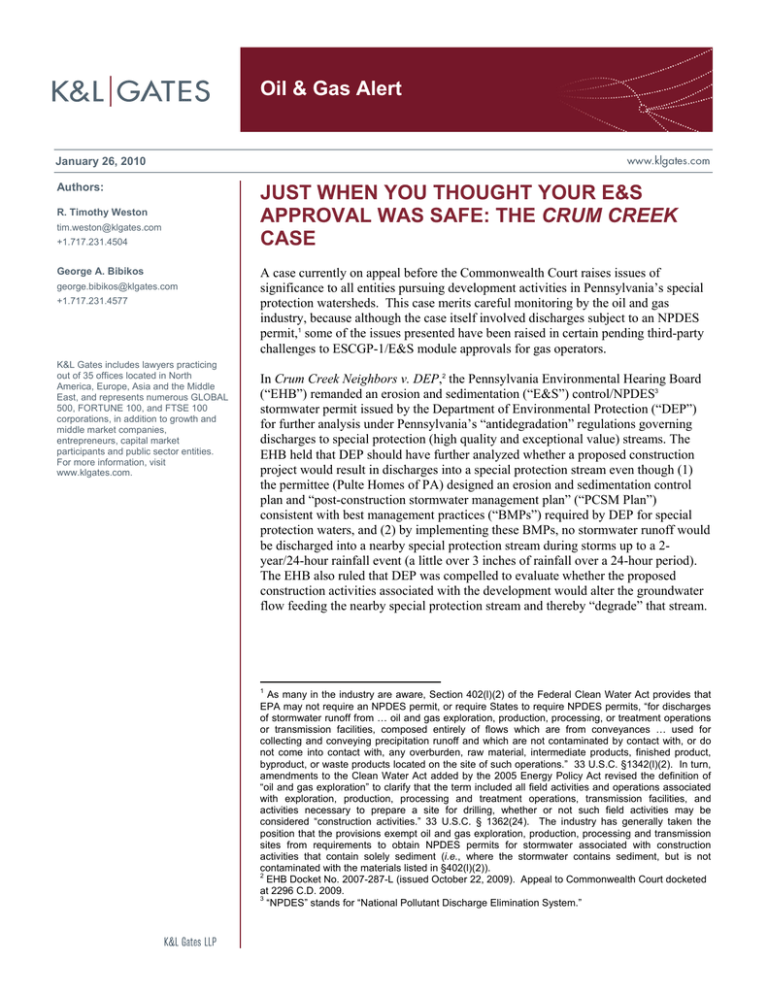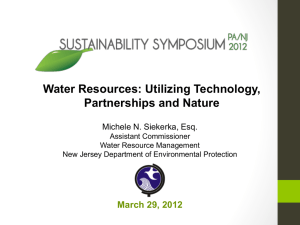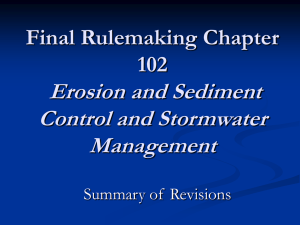
Oil & Gas Alert
January 26, 2010
Authors:
R. Timothy Weston
tim.weston@klgates.com
+1.717.231.4504
George A. Bibikos
george.bibikos@klgates.com
+1.717.231.4577
K&L Gates includes lawyers practicing
out of 35 offices located in North
America, Europe, Asia and the Middle
East, and represents numerous GLOBAL
500, FORTUNE 100, and FTSE 100
corporations, in addition to growth and
middle market companies,
entrepreneurs, capital market
participants and public sector entities.
For more information, visit
www.klgates.com.
JUST WHEN YOU THOUGHT YOUR E&S
APPROVAL WAS SAFE: THE CRUM CREEK
CASE
A case currently on appeal before the Commonwealth Court raises issues of
significance to all entities pursuing development activities in Pennsylvania’s special
protection watersheds. This case merits careful monitoring by the oil and gas
industry, because although the case itself involved discharges subject to an NPDES
permit,1 some of the issues presented have been raised in certain pending third-party
challenges to ESCGP-1/E&S module approvals for gas operators.
In Crum Creek Neighbors v. DEP,2 the Pennsylvania Environmental Hearing Board
(“EHB”) remanded an erosion and sedimentation (“E&S”) control/NPDES3
stormwater permit issued by the Department of Environmental Protection (“DEP”)
for further analysis under Pennsylvania’s “antidegradation” regulations governing
discharges to special protection (high quality and exceptional value) streams. The
EHB held that DEP should have further analyzed whether a proposed construction
project would result in discharges into a special protection stream even though (1)
the permittee (Pulte Homes of PA) designed an erosion and sedimentation control
plan and “post-construction stormwater management plan” (“PCSM Plan”)
consistent with best management practices (“BMPs”) required by DEP for special
protection waters, and (2) by implementing these BMPs, no stormwater runoff would
be discharged into a nearby special protection stream during storms up to a 2year/24-hour rainfall event (a little over 3 inches of rainfall over a 24-hour period).
The EHB also ruled that DEP was compelled to evaluate whether the proposed
construction activities associated with the development would alter the groundwater
flow feeding the nearby special protection stream and thereby “degrade” that stream.
1
As many in the industry are aware, Section 402(l)(2) of the Federal Clean Water Act provides that
EPA may not require an NPDES permit, or require States to require NPDES permits, “for discharges
of stormwater runoff from … oil and gas exploration, production, processing, or treatment operations
or transmission facilities, composed entirely of flows which are from conveyances … used for
collecting and conveying precipitation runoff and which are not contaminated by contact with, or do
not come into contact with, any overburden, raw material, intermediate products, finished product,
byproduct, or waste products located on the site of such operations.” 33 U.S.C. §1342(l)(2). In turn,
amendments to the Clean Water Act added by the 2005 Energy Policy Act revised the definition of
“oil and gas exploration” to clarify that the term included all field activities and operations associated
with exploration, production, processing and treatment operations, transmission facilities, and
activities necessary to prepare a site for drilling, whether or not such field activities may be
considered “construction activities.” 33 U.S.C. § 1362(24). The industry has generally taken the
position that the provisions exempt oil and gas exploration, production, processing and transmission
sites from requirements to obtain NPDES permits for stormwater associated with construction
activities that contain solely sediment (i.e., where the stormwater contains sediment, but is not
contaminated with the materials listed in §402(l)(2)).
2
EHB Docket No. 2007-287-L (issued October 22, 2009). Appeal to Commonwealth Court docketed
at 2296 C.D. 2009.
3
“NPDES” stands for “National Pollutant Discharge Elimination System.”
Oil & Gas Alert
The permittee has appealed the EHB’s decision to
Commonwealth Court, and the issues raised in the
case potentially affect many types of development
across the forested and higher quality watersheds of
Pennsylvania.
Regulatory Background
DEP regulates stormwater runoff and related erosion
and sedimentation associated with construction
activities under the Clean Streams Law and
Pennsylvania’s Chapter 102 rules. The Chapter 102
regulations require that persons obtain a permit
before conducting any activity involving five acres
or more of earth disturbance.4 The Chapter 102
rules contain particular provisions governing erosion
and sedimentation controls in special protection
watersheds (those streams classified as “high
quality” (“HQ”) or “exceptional value” (“EV”).
Specifically, 25 Pa. Code § 102.4(b)(6) provides that
where an earth disturbance activity may result in a
discharge to streams classified as HQ or EV, the
person undertaking the activity must use “Special
Protection BMPs to maintain and protect the water
from degradation.” As part of DEP’s
Comprehensive Stormwater Management Policy,5
DEP has sought to require that applicants seeking a
Chapter 102 permit in special protection watersheds
design and implement a PCSM Plan that is designed
to infiltrate stormwater runoff to the maximum
extent possible.6 For the past several years, DEP has
followed an guideline where it considers BMPs that
control and avoid discharges during a 2-year/24hour storm as representing a “no discharge” Special
Protection BMP.7
Separately, the Chapter 93 water quality regulations
contain general “antidegradation” requirements,
including mandates for protection of existing uses of
all streams, and rules governing discharges to
4
The current wording of 25 Pa. Code §102.5 refers to
obtaining an “NPDES Permit for Stormwater Associated with
Construction Activities,” while the Clean Water Act would
indicate that oil and gas E&P activities are not subject to
NPDES permit requirements absent contamination by certain
materials. See footnote 1 above.
5
DEP Doc. No. 392-0300-002 (Sept. 28, 2002).
6
Id. at 2.
7
DEP, Pennsylvania Stormwater Best Management Practices
Manual, Doc. No. 363-0300-002, §3.3.3 (Dec. 30, 2006)
(referring to Control Guidance 1), see Crum Creek Neighbors
v. DEP, EHB Docket No. 2007-287-L (Adjudication, Oct. 22,
2009) at 16.
special protection waters. Under the Chapter 93
rules, a point source discharge into special
protection waters may be approved if (i) there is no
feasible, environmentally sound and cost-effective
non-discharge alternative; (ii) the best available
combination of cost-effective treatment, land
disposal, pollution prevention and wastewater reuse
technologies (“ABACT”) is being used; and (iii) the
resulting discharge will maintain and protect the
existing water quality of the stream, or (for HQ
streams) the resulting degradation has necessary
economic or social justification.8 The foregoing
apply to “point source” discharges (discharges from
pipes and other conveyances); and in contrast, the
Chapter 93 rules provide that as to non-point
discharges, DEP must “assure that cost-effective
and reasonable best management practices … are
achieved.”
Stormwater runoff is generally considered to be a
“non-point source” discharge; and one of the
questions that has swirled through the E&S and
stormwater program is the interplay between the
general Chapter 93 regulations and the specific
Chapter 102 E&S rules.
In Blue Mountain Preservation Association v. DEP
& Alpine Rose Resorts, Inc., the EHB held that the
Chapter 93 rules must be considered and applied in
issuing E&S/NPDES stormwater permits. The EHB
in that case did not spend much time differentiating
between point and non-point sources, and
apparently assumed that the runoff discharges in
that instance would represent increased point source
discharges into special protection waters. The Blue
Mountain Preservation Association decision ruled
that DEP could not issue a permit even if it was
satisfied that the permittee demonstrated
compliance with and implemented special
protection BMPs approved by DEP. Instead, before
issuing an E&S/NPDES permit for stormwater
associated with construction activities, DEP must
consider and meet the same criteria as for all other
point source discharges.
The Crum Creek Project
In the Crum Creek case, Pulte Homes (“Pulte”)
proposed a housing development known as Sentinel
8
25 Pa. Code § 93.4c(b).
January 26, 2010
2
Oil & Gas Alert
Ridge in Marple Township, Delaware County,
Pennsylvania, and applied for a Chapter 102
E&S/NPDES stormwater permit for the associated
earth disturbance. The permit authorized about 20
acres of earth disturbance on a 35-acre tract. The
western half of development lay in the watershed of
Crum Creek, a “warm water fishery” (“WWF”),
while the eastern portion of the project was situated
in the watershed of Holland Run, the upper section
of which was classified as EV. Pulte’s plans called
for stormwater discharges under most circumstances
to occur below a culvert that demarked the boundary
between the EV portion of Holland Run and the
downstream WWF reach.
As part of the project approval, DEP required that
Pulte prepare and implement plans to prevent
discharges into the EV portion of Holland Run. The
E&S plans and PCSM Plan included both structural
and nonstructural BMPs designed to divert all
stormwater runoff from the eastern side of the
project site that would otherwise flow to the EV
portion of Holland Run. Those plans included
various stormwater retention and recharge basins
equipped to handle anything up to a 2-year, 24-hour
storm. Accordingly, the main stormwater
management system for the proposed housing
development was designed based on DEP’s BMPs to
discharge to the WWF section of Holland Run, not
the EV section.
DEP issued the E&S/NPDES stormwater permit,
and the permit was challenged by Crum Creek
Neighbors (“CCN”), a local citizens group. As later
confirmed by testimony during the EHB
proceedings, DEP concluded that (1) the E&S
controls and stormwater management plan complied
with DEP policy, implemented approved BMPs, and
comported with accepted engineering practices; and
(2) based on the design, there would be no
discharges into the EV portion of Holland Run.
DEP also acknowledged that it did not evaluate
whether the proposed development (including
extensive grading and changes to topography)
coupled with the stormwater system might affect
groundwater flows from the unnamed tributary
feeding the EV portion of Holland Run.
The EHB’s Decision
The EHB did not rescind the permit issued to Pulte,
but remanded the matter back to DEP for more
analysis. In that process, the EHB made two key
rulings.
First, accepting the testimony of CCN’s expert, the
EHB found that during heavy storms, the
stormwater recharge basins probably would
overflow through their spillways, thereby resulting
in a discharge into the EV section of Holland Run.
On this basis, the EHB concluded that DEP should
not have treated the E&S/stormwater plan as though
it were designed to prevent any discharge into the
special protection stream. Significantly, the EHB
rejected DEP’s and the permittee’s reliance on
BMPs designed to control a 2-year, 24-hour storm
as per se defining acceptable controls meeting
antidegradation requirements. Instead, the EHB
concluded that DEP must conduct a more in-depth
review of (i) whether other non-discharge
alternatives had been adequately evaluated; (ii)
whether the plans incorporated ABACT
technologies; and (iii) whether the discharges
occurring during such rare, heavy storms would
result in degradation of stream quality.
Second, the EHB determined that DEP did not
adequately evaluate whether the proposed
construction activities would affect the groundwater
flowing to Holland Run and thereby cause an
adverse impact on the baseflow of that EV stream.
The EHB concluded that DEP should have
evaluated whether the construction activities
coupled with the stormwater system might affect
groundwater flows from the unnamed tributary
feeding the EV portion of Holland Run. In making
this finding, the EHB stated: “The principle that
degrading a stream by materially changing its
movement, circulation, or flow is prohibited has
been repeated in numerous other cases and it is now
beyond dispute.” (Despite this statement, many in
the regulated community may find the EHB’s
expansive view of the antidegradation surprising
and troubling, as it suggests that a potentially wide
range of quantity/quality issues, and not just
discharges, will fall under the antidegradation
analysis lens.)
The permittee’s appeal to Commonwealth Court is
currently pending, but Commonwealth Court has
asked for briefing on whether the EHB’s order is
even subject to appeal at this time because the EHB
January 26, 2010
3
Oil & Gas Alert
remanded the matter to DEP for further evaluation
under antidegradation regulations.
special protection watersheds require careful
planning and additional diligence.
Conclusion
Permit applicants already bear the burden of
designing E&S and stormwater management plans
that comply with regulatory requirements,
implement BMPs approved by DEP, and comport
with accepted engineering practices. The EHB’s
decision in Crum Creek suggests that a permittee
may not be able to rely on DEP’s permit approval
even if the applicant submits plans that comply with
regulatory requirements and implements BMPs to
avoid or minimize discharges into a special
protection waterway. Moreover, the EHB’s
apparently expansive view of the Chapter 93
antidegradation rules, which opens up consideration
of indirect impacts on water quantity and quality,
such as groundwater flow disruption, presents
significant challenges to both DEP and those
attempting to plan projects.
It will be important to track whether and how the
Commonwealth Court deals with this case on
appeal, and how DEP handles the remand of the
Crum Creek permit. At the same time, it is hoped
that clarification of the interplay between the
Chapter 102 E&S rules and Chapter 93 general
water quality regulations might be achieved through
pending amendments to the Chapter 102
regulations,9 but the outcome of that regulatory
process remains uncertain.
Although it is difficult to predict how Crum Creek
and the pending Chapter 102 rule changes will affect
permit applications going forward, the industry must
certainly keep a watchful eye on this pending case.
At the same time, the decision, at a minimum, serves
as a reminder that earth-disturbance activities in
9
See 39 Pa.B. 5131 (August 29, 2009) (notice of proposed
rulemaking). The comment period on the proposed rules
ended November 30, 2009, and further revisions are expected
to be considered as part of a final rulemaking package that is
anticipated will be submitted to the Environmental Quality
Board for final action in the next several months. The
Department's recommended response to public comments and
a draft of the final rulemaking package was anticipated to be
on the agenda for a meeting of the Water Resources Advisory
Committee on February 10, 2010, but that draft had not yet
been released as of the time of this writing.
January 26, 2010
4
Oil & Gas Alert
Anchorage Austin Beijing Berlin Boston Charlotte Chicago Dallas Dubai Fort Worth Frankfurt Harrisburg Hong Kong London
Los Angeles Miami Moscow Newark New York Orange County Palo Alto Paris Pittsburgh Portland Raleigh Research Triangle Park
San Diego San Francisco Seattle Shanghai Singapore Spokane/Coeur d’Alene Taipei Tokyo Washington, D.C.
K&L Gates includes lawyers practicing out of 35 offices located in North America, Europe, Asia and the Middle East, and represents numerous
GLOBAL 500, FORTUNE 100, and FTSE 100 corporations, in addition to growth and middle market companies, entrepreneurs, capital market
participants and public sector entities. For more information, visit www.klgates.com.
K&L Gates is comprised of multiple affiliated entities: a limited liability partnership with the full name K&L Gates LLP qualified in Delaware and
maintaining offices throughout the United States, in Berlin and Frankfurt, Germany, in Beijing (K&L Gates LLP Beijing Representative Office), in
Dubai, U.A.E., in Shanghai (K&L Gates LLP Shanghai Representative Office), in Tokyo, and in Singapore; a limited liability partnership (also named
K&L Gates LLP) incorporated in England and maintaining offices in London and Paris; a Taiwan general partnership (K&L Gates) maintaining an
office in Taipei; a Hong Kong general partnership (K&L Gates, Solicitors) maintaining an office in Hong Kong; and a Delaware limited liability
company (K&L Gates Holdings, LLC) maintaining an office in Moscow. K&L Gates maintains appropriate registrations in the jurisdictions in which its
offices are located. A list of the partners or members in each entity is available for inspection at any K&L Gates office.
This publication is for informational purposes and does not contain or convey legal advice. The information herein should not be used or relied upon
in regard to any particular facts or circumstances without first consulting a lawyer.
©2010 K&L Gates LLP. All Rights Reserved.
January 26, 2010
5







